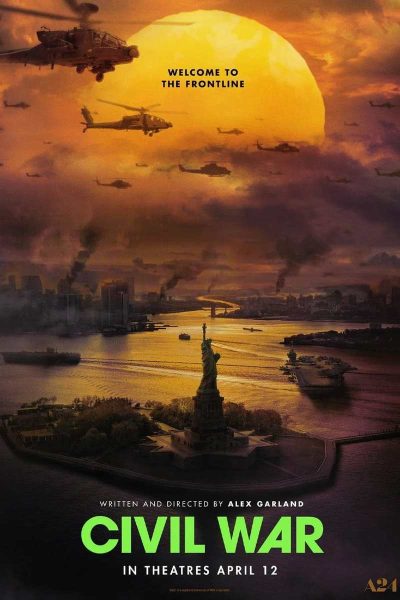By Eric Lindbom
Four Snakes out of Five
With CIVIL WAR (in theaters), writer/director Alex Garland shoves us into the deep end of the pool without narrative life jackets. In an unexplained war torn America, gun crazy citizen militias and secessionists battle trigger happy soldiers from a bullying government. CIVIL WAR literally opens with a bang with a suicide bomber toppling both sides of riotous mob. The exploding terrorist waves an American flag. Is he patriotic, anarchic, or sarcastic? Does it matter? In this unsettling, immersive story, we’re shook bystanders as likely to duck for cover as rubber neck amidst the ongoing ping of ricocheting bullets.
Trying to record, vs. make sense, of the chaos are three journalists, an unflappable photographer Lee (Kirsten Dunst), war correspondent Joel (Wagner Moura), and aging reporter vet Sammy (Stephen McKinley Henderson). They’re chasing a cross country scoop, via a road trip from New York to DC, to try an ambush interview the flailing third term President (Nick Offerman) before he’s overthrown. This is a kamikaze mission as reporters are presently shot on sight on the White House lawn. Jessie, a young admirer of Lee (Cailee Spaeny), tags along against Lee’s better judgment; she’s high on the excitement and freaked by the bloodshed.

Garland calls CIVIL WAR a salute to the press a too underappreciated institution considering the dangers they face (the Committee to Protect Journalists (CPJ) claims nearly 100 journalists and media workers are among the more than 30,000 killed in Gaza). However, other than an early scene of Lee trying to download files with iffy Wi-Fi to her editors, there’s not a lot of reporting going on. Our heroes’ jobs lets us cozy up to supposedly objective characters who don’t take sides.
Despite the uniformly fine performances (the cast veers between news junkie recklessness and trauma at the barbarism they witness) that’s apparently not enough for some. A Hollywood Reporter story headlined “Why Civil War Makes Audiences Uncomfortable” notes the film is “difficult to watch because it does not give people clearly defined sides to root for or against.” To me, this is Garland’s point as he’s focusing not on the causes but the effects of polarization and (in one amusing scene) apathy.
Prescriptive feedback, bemoaned by writing instructors, denotes judging not the material in front of us but viewing it through the prism of the story we wish to see. So no CIVIL WAR isn’t the red vs. blue state Hatfield McCoy feud some might prefer nor does it weigh in on specific divisive political positions. While I didn’t find this evasive, it does lead to some plausibility whoppers (we’re supposed to believe that Texas and California are mutual secessionist buddies?).
Despite the lack of podium pounding, CIVIL WAR isn’t devoid of world building and has slivers of wit (ever neutral Canada’s currency is now sought, bridge graffiti reads “Go Steelers” since the NFL apparently still exists and there’s a shrewd gag about embedded journalists).

Taken on its own terms, CIVIL WAR (tuned twice to the throbbing key of Alan Vega and Martin Rev’s band Suicide, tech kings of apocalyptic dread) consistently grips. There’s also a harrowing sequence with Jesse Plemons as a dead pan, murderous Xenophobe (his accusatory line “what kind of American are you?” drives the movie trailer). The wary interactions between the reporters and locals generate more tension than the increasingly bombastic battle scenes (my big gripe was an incredulous and oddly flat final reel). Above all, CIVIL WAR has a premium cable dose of relevance that elevates it above our current glut of dystopia diarrhea.
If CIVIL WAR is a cautionary tale for viewers it’s also one for A24. The producer/distributor is so aligned with buzzworthy quality these years that cinephiles are rightly brand loyal. At more than $50 million in production costs this time, here’s hoping A24 doesn’t fall prey to chasing the big buck swings that almost toppled Twentieth Century Fox (see CLEOPATRA) and United Artists (HEAVENS GATE). That’s a cultural war both A24 and we can’t afford to lose.
Eric Lindbom is a hardcore horror buff with a strong stomach, weaned on the Universal classics from the ’30s and ’40s. He’s written film and/or music reviews for City Pages, Twin Cities Reader, LA WEEKLY, Request magazine and Netflix. He co-edits triggerwarningshortfiction.com, a site specializing in horror, fantasy and crime short stories with illustrations by co-editor John Skewes. He lives in Los Angeles.







